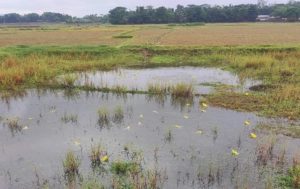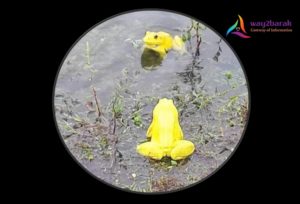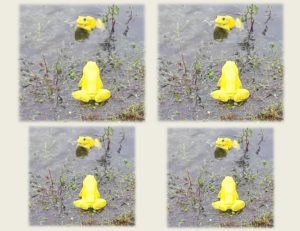Barak UpdatesHappeningsBreaking News
Frogs which changes colour to yellow during mating season sighted 1st time in Barak Valleyসঙ্গিনীকে আকৃষ্ট করতে হলুদ হয়ে যায় এরা, নয়াগ্রামে নতুন ব্যাঙ

May 15: With the advent of the rainy season, frogs can be often seen in our vicinity especially in all the three districts of Barak Valley. However, such a sight for some people at Nayagram in Karimganj district on Saturday morning was indeed an experience to be remembered throughout their lives. In front of their eyes, they saw two bright yellow coloured frogs trying to swim in the water which accumulated in the ground due to heavy rainfall in the morning.

Soon the picture of the frogs became viral in social media. Various stories began to be narrated by the people centering these yellow coloured frogs. Some regarded it as auspicious, while many others aired the view that nature has grown angry and so everything is changing, which a few went to the extent of regarding as the approaching of the days of destruction. Well, the yellow frogs became the talk of the people for the entire day.
 However, way2barak out of its quest for the truth, discussed the matter with Prof. Parthankar Choudhury- formed Head, Department of Ecology & Environment Science, Assam University and Sunnedeo Choudhury- District Forest Officer (DFO). Both of them instantly rubbished the claims of auspicious or evil symptoms associated with the sighting of the yellow frogs and termed such views as “superstitious, baseless & unscientific.”
However, way2barak out of its quest for the truth, discussed the matter with Prof. Parthankar Choudhury- formed Head, Department of Ecology & Environment Science, Assam University and Sunnedeo Choudhury- District Forest Officer (DFO). Both of them instantly rubbished the claims of auspicious or evil symptoms associated with the sighting of the yellow frogs and termed such views as “superstitious, baseless & unscientific.”

Prof. Parthankar Choudhury said, “This seems to be the 1st report of sighting of yellow frogs in Barak Valley.” He along with the DFO Cachar opined that these frogs (Indian Bullfrog- Hoplobatrachus Tigerinus) is a large species of frog that occur in South and South East Asia. More attractive the male is, more brighter the skin colour is. They are nocturnal, mostly eat on insects, and occasionally small birds, if found nearby. They can jump on the water surface, just as other frogs can do hopping on land surfaces.
 As per International Union for Conservation of Nature & Narural Resources (IUCN), these frogs are included under LEAST CONCERNED category. The Indian bullfrog, native to the Indian subcontinent, is currently an invasive species in the Andaman archipelago in the Bay of Bengal. Yet, little is known about the impact it could have on native species. Now, a study has revealed that tadpoles of the Indian bullfrog quickly devoured native tadpoles when they were housed together. However, Dr. Parthankar Choudhury said, “Without authentic data, it cannot be labeled as invasive in Barak Valley.”
As per International Union for Conservation of Nature & Narural Resources (IUCN), these frogs are included under LEAST CONCERNED category. The Indian bullfrog, native to the Indian subcontinent, is currently an invasive species in the Andaman archipelago in the Bay of Bengal. Yet, little is known about the impact it could have on native species. Now, a study has revealed that tadpoles of the Indian bullfrog quickly devoured native tadpoles when they were housed together. However, Dr. Parthankar Choudhury said, “Without authentic data, it cannot be labeled as invasive in Barak Valley.”
 Part of the Indo-Burma biodiversity hotspot, the Andaman archipelago consists of 300 tropical islands with 40 per cent of its reptiles and amphibians endemic to the area – residing only in the islands. As a result, these species are vulnerable when faced with invasions by exotic species.
Part of the Indo-Burma biodiversity hotspot, the Andaman archipelago consists of 300 tropical islands with 40 per cent of its reptiles and amphibians endemic to the area – residing only in the islands. As a result, these species are vulnerable when faced with invasions by exotic species.
 According to science website ZME Science, the Indian bullfrog changes colour drastically during mating season in monsoons. While the frogs turn bright yellow from a dull green, their vocal sacks turn blue. It is believed that the more brightly-coloured a male frog is, the more attractive it is considered.
According to science website ZME Science, the Indian bullfrog changes colour drastically during mating season in monsoons. While the frogs turn bright yellow from a dull green, their vocal sacks turn blue. It is believed that the more brightly-coloured a male frog is, the more attractive it is considered.
 When asked, as to why this species was suddenly visible in Barak Valley (Karimganj district), Prof. Parthankar Choudhury said, “It might be possible that such frogs were already there, but did not come to anybody’s notice all these days or maybe in the past people noticed but had not reported them. The sighting of these yellow coloured frogs at Nayagram in Karimganj district is the 1st reported instance from Barak Valley.”
When asked, as to why this species was suddenly visible in Barak Valley (Karimganj district), Prof. Parthankar Choudhury said, “It might be possible that such frogs were already there, but did not come to anybody’s notice all these days or maybe in the past people noticed but had not reported them. The sighting of these yellow coloured frogs at Nayagram in Karimganj district is the 1st reported instance from Barak Valley.”





